
Mariology is the study of Mary, the mother of Jesus, and her role in Christianity. This field explores her life, virtues, and significance within the faith. Why is Mariology important? Because it helps believers understand Mary's unique position and her influence on Christian doctrine. From her immaculate conception to her assumption into heaven, Mary’s story is filled with fascinating details that have shaped religious thought for centuries. Whether you're a devout follower or just curious, learning about Mariology can deepen your appreciation for this central figure in Christianity. Ready to dive into 20 intriguing facts about Mariology? Let’s get started!
What is Mariology?
Mariology is the theological study of Mary, the mother of Jesus. This field explores her role in salvation history, her virtues, and her significance in the Christian faith. Here are some fascinating facts about Mariology.
-
Mariology examines Mary's role in the Incarnation, emphasizing her as the mother of Jesus Christ, who is both God and man.
-
The term "Mariology" comes from the Latin word "Maria" and the Greek word "logos," meaning "study" or "discourse."
-
Early Christian writers like St. Irenaeus and St. Augustine contributed significantly to Mariological thought.
Key Doctrines in Mariology
Several key doctrines form the foundation of Mariology. These doctrines highlight Mary's unique role and her relationship with Jesus and the Church.
-
The Immaculate Conception doctrine states that Mary was conceived without original sin.
-
The Assumption of Mary teaches that Mary was taken body and soul into heavenly glory at the end of her earthly life.
-
The Perpetual Virginity of Mary asserts that she remained a virgin before, during, and after the birth of Jesus.
Marian Apparitions
Marian apparitions are reported supernatural appearances of Mary. These events have had a profound impact on the faithful and have led to the establishment of numerous shrines and pilgrimage sites.
-
The apparition of Our Lady of Guadalupe in 1531 is one of the most famous, where Mary appeared to Juan Diego in Mexico.
-
In 1858, Mary appeared to Bernadette Soubirous in Lourdes, France, leading to the creation of a major pilgrimage site.
-
The apparitions at Fatima in 1917, where Mary appeared to three shepherd children in Portugal, are also widely recognized.
Marian Titles and Symbols
Mary is known by many titles and symbols that reflect her virtues and roles within the Church. These titles and symbols help the faithful connect with her on a deeper level.
-
Our Lady of Sorrows refers to Mary's suffering and grief, particularly during Jesus' crucifixion.
-
Queen of Heaven is a title that emphasizes Mary's exalted status in heaven.
-
The Rose is a symbol often associated with Mary, representing her purity and beauty.
Marian Prayers and Devotions
Prayers and devotions dedicated to Mary are an integral part of Christian spirituality. These practices help believers seek her intercession and grow in their faith.
-
The Hail Mary is one of the most well-known Marian prayers, asking for Mary's intercession.
-
The Rosary is a devotional prayer that involves meditating on the mysteries of Christ's life through Mary's perspective.
-
The Angelus is a prayer recited three times a day, commemorating the Annunciation.
Mary in Art and Literature
Mary has been a central figure in Christian art and literature for centuries. Her image and story have inspired countless works that continue to captivate and inspire.
-
The Pietà by Michelangelo depicts Mary holding the body of Jesus after his crucifixion, showcasing her sorrow and strength.
-
Dante's Divine Comedy features Mary as a symbol of divine grace and intercession.
-
The Annunciation by Leonardo da Vinci captures the moment when the angel Gabriel announces to Mary that she will bear the Son of God.
Mary in Different Christian Traditions
Different Christian traditions have unique perspectives on Mary, reflecting their theological and cultural contexts.
-
In Eastern Orthodoxy, Mary is venerated as the Theotokos, meaning "God-bearer," emphasizing her role in the Incarnation.
-
Protestant traditions generally do not emphasize Marian doctrines as much as Catholic and Orthodox traditions, focusing more on her role in the biblical narrative.
Final Thoughts on Mariology
Mariology, the study of Mary, Mother of Jesus, offers a rich tapestry of history, theology, and devotion. From her role in the Annunciation to her Assumption, Mary has inspired countless believers and scholars. Understanding her Immaculate Conception and Perpetual Virginity deepens our grasp of Christian doctrine. Her appearances in apparitions like Lourdes and Fatima continue to captivate the faithful. Whether you're a devout Catholic or just curious, exploring Mariology can enrich your spiritual journey. It’s fascinating to see how Mary’s influence spans cultures and centuries, making her a pivotal figure in Christianity. Dive into the texts, traditions, and teachings to uncover more about this remarkable woman. Mariology isn't just about the past; it’s a living, breathing part of faith today. So, keep learning, questioning, and discovering the profound impact of Mary in the world.
Was this page helpful?
Our commitment to delivering trustworthy and engaging content is at the heart of what we do. Each fact on our site is contributed by real users like you, bringing a wealth of diverse insights and information. To ensure the highest standards of accuracy and reliability, our dedicated editors meticulously review each submission. This process guarantees that the facts we share are not only fascinating but also credible. Trust in our commitment to quality and authenticity as you explore and learn with us.


